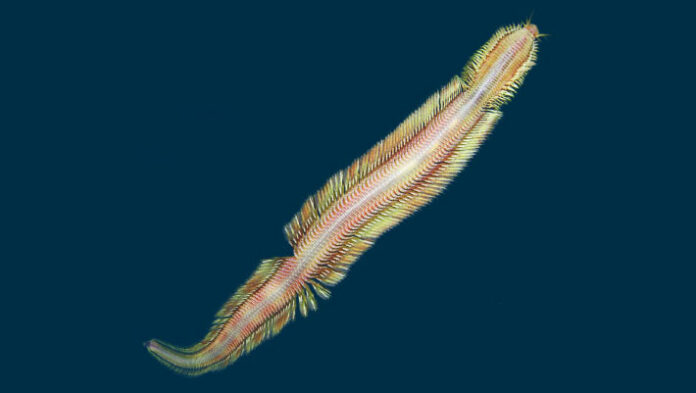Marine biologists from the Scripps Institution of Oceanography at the University of California, San Diego, and the Centro de Investigación Científica y de Educación Superior de Ensenada have described an unusual new deep-sea worm species with gills found at methane seeps off the Pacific coast of Costa Rica. Named Pectinereis strickrotti, the new species has an elongated body that is flanked by a row of feathery, gill-tipped appendages called parapodia on either side.
Pectinereis strickrotti belongs to Nereididae, a family of over 700 accepted species of segmented, mostly-marine worms.
Commonly called ragworms, these creatures generally known from coastal regions, commonly confined to shallow marine habitats, although they also occur in brackish, freshwater, and even moist terrestrial environments.
However, approximately 10% of the total diversity is known from deep-sea habitats.
These worms have very elongated bodies with rows of bristled parapodia on their sides and a hidden set of pincer-shaped jaws that can be extruded for feeding.
Many species of ragworms also have two distinct life stages: atoke and epitoke.
In these species, the worm spends most of its life on the seafloor, often in a burrow, as a sexually immature atoke, but in their life’s final act they transform into sexually mature epitokes that swim up off the bottom into the water column to find mates and spawn.
Pectinereis strickrotti was first encountered in 2009 at a depth of around 1,000 m (3,280 feet) during a dive in the Alvin submersible.
“We saw two worms near each other about a sub’s length away swimming just off the bottom,” said Woods Hole Oceanographic Institution researcher Bruce Strickrott.
“We couldn’t see them well and tried to creep in for a closer look, but it’s hard to creep in a submarine and we spooked them.”
Finally, in 2018 the team was able to return to Costa Rica’s methane seeps with Alvin.
On a dive to the same spot the worm was first sighted, Dr. Strickrott was astounded to encounter six or more individuals of the unidentified species they first saw there nearly a decade earlier.
For some reason, the worms were much less skittish than they were in 2009 and, using a five-chambered vacuum canister device on Alvin, they carefully collected several specimens as well as images and video — enough to formally describe what proved to be a new species.
The researchers were able to collect three male Pectinereis strickrotti epitokes and part of one female.
Following their collection, they used the specimens to conduct anatomical analysis and to study the worm’s DNA to establish its evolutionary relationships within the Nereididae family.
“Compared to most ragworms, Pectinereis strickrotti is unusual in several ways,” said Dr. Greg Rouse, a marine biologist at the Scripps Institution of Oceanography at the University of California.
“First, it lives in the deep sea, while the majority of its evolutionary kin inhabit shallower waters.”
“Second, its parapodia are covered in gills, while most ragworms absorb oxygen through their parapodia without the aid of true gills.”
“The males had large spines at the end of their tails, which might have something to do with reproduction but would require further study.”
“Finally, owing to the total darkness at 1,000 m under the sea, the new species is blind.”
“The worms probably have keen senses of smell and touch to help them navigate their inky world.”
Pectinereis strickrotti has robust, even fearsome-looking jaws, but their diet is still unknown and that the species could just as easily be feeding on bacteria as larger fare like other worms.
Though its coloration would be a moot point in life, given its pitch black habitat, the worm appeared rosy under Alvin’s lights, and that this was probably due to the color of its blood.
“We’ve spent years trying to name and describe the biodiversity of the deep sea,” Dr. Rouse said.
“At this point we have found more new species than we have time to name and describe.”
“It just shows how much undiscovered biodiversity is out there.”
“We need to keep exploring the deep sea and to protect it.”
The discovery is reported in a paper published online in the journal PLoS ONE.
_____
T.F. Villalobos-Guerrero et al. 2024. A remarkable new deep-sea nereidid (Annelida: Nereididae) with gills. PLoS ONE 19 (3): e0297961; doi: 10.1371/journal.pone.0297961


